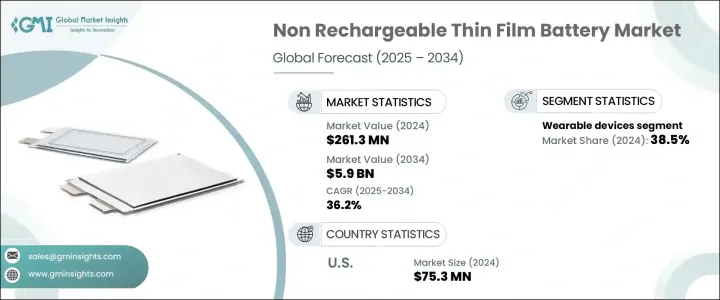PUBLISHER: Global Market Insights Inc. | PRODUCT CODE: 1740929

PUBLISHER: Global Market Insights Inc. | PRODUCT CODE: 1740929
Non Rechargeable Thin Film Battery Market Opportunity, Growth Drivers, Industry Trend Analysis, and Forecast 2025 - 2034
The Global Non-Rechargeable Thin Film Battery Market was valued at USD 261.3 million in 2024 and is estimated to grow at a CAGR of 36.2% to reach USD 5.9 billion by 2034, driven by the escalating demand for compact and efficient energy solutions across next-generation electronic devices. As devices become increasingly smaller and more powerful, industries like consumer electronics, medical wearables, and IoT are pushing the need for flexible, high-performance power supplies. Non-rechargeable thin film batteries, known for their lightweight structure, extended shelf life, and versatile design adaptability, are becoming crucial components in powering micro-devices without sacrificing energy efficiency or reliability.

The market is witnessing strong traction as advancements in miniaturization, 5G connectivity, and smart device ecosystems take center stage. Manufacturers across sectors are leaning toward thin film technologies to meet aggressive form factor requirements without compromising on voltage stability or safety. With environmental sustainability also gaining prominence, the thin film battery's ability to reduce electronic waste by offering durable, maintenance-free solutions makes it an even more attractive choice for tech innovators. These batteries are also align well with the shift toward solid-state energy storage systems, which promise better safety, energy density, and life cycle performance. As innovation continues to drive down manufacturing costs and improve scalability, the addressable market for non-rechargeable thin film batteries is set to widen further across healthcare, industrial automation, aerospace, and next-gen consumer gadgets.
| Market Scope | |
|---|---|
| Start Year | 2024 |
| Forecast Year | 2025-2034 |
| Start Value | $261.3 Million |
| Forecast Value | $5.9 Billion |
| CAGR | 36.2% |
Devices like health trackers, digital hearing aids, and ultra-thin smartwatches are increasingly depending on these compact batteries due to their ability to deliver stable voltage in tight form factors. With the rapid expansion of IoT deployments across smart infrastructure, remote sensing, and industrial automation, the need for low-profile, long-lasting, and reliable energy sources is intensifying. Thin film batteries, offering strong compatibility with solid-state technology and customizable designs, are ideally suited for these evolving needs. Breakthroughs in solid-state electrolytes and enhanced construction techniques are further boosting battery performance, reliability, and production scalability. Developers are working on enhancing power density and safety standards while simultaneously extending operational life.
The wearable device segment accounted for a 38.5% share in 2024, highlighting strong demand for batteries that meet sleek and ergonomic design requirements. Their flexibility allows seamless integration into curved, miniaturized consumer wearables, supporting both health-focused and lifestyle devices. Long-lasting, maintenance-free power ensures a consistent user experience. Meanwhile, the surge in compact healthcare electronics, such as ingestible sensors and implantable monitors, opens new growth avenues, as these devices require steady output over long durations while occupying minimal space.
The United States Non-Rechargeable Thin Film Battery Market generated USD 75.3 million in 2024, rising from USD 40.1 million in 2022, reflecting strong momentum in next-generation energy storage technologies. A well-developed RandD ecosystem featuring collaboration among federal agencies, national labs, startups, and industry leaders is fueling rapid innovation. Government initiatives emphasizing energy efficiency are further driving investments into thin film and solid-state technologies.
Major players in the Global Non-Rechargeable Thin Film Battery Market include Jenax, Ion Storage Systems, ITEN, Molex, Ilika, Cymbet, STMicroelectronics, Johnson Energy Storage, Prieto Battery, Imprint Energy, BrightVolt, and Enfucell. Key strategies include focusing on ultra-thin designs for medical and wearable tech, forming collaborations with electronics manufacturers, investing in pilot-scale production, improving solid-state architectures, and diversifying applications to strengthen long-term supply agreements and market reach.
Table of Contents
Chapter 1 Methodology & Scope
- 1.1 Market definitions
- 1.2 Base estimates & calculations
- 1.3 Forecast calculation
- 1.4 Data sources
- 1.4.1 Primary
- 1.4.2 Secondary
- 1.4.2.1 Paid
- 1.4.2.2 Public
Chapter 2 Executive Summary
- 2.1 Industry synopsis, 2021 - 2034
Chapter 3 Industry Insights
- 3.1 Industry ecosystem analysis
- 3.2 Trade administration tariff analysis
- 3.2.1 Impact on trade
- 3.2.1.1 Trade volume disruptions
- 3.2.1.2 Retaliatory measures
- 3.2.2 Impact on the industry
- 3.2.2.1 Supply-side impact (raw materials)
- 3.2.2.1.1 Price volatility in key materials
- 3.2.2.1.2 Supply chain restructuring
- 3.2.2.1.3 Production cost implications
- 3.2.2.2 Demand-side impact (selling price)
- 3.2.2.2.1 Price transmission to end markets
- 3.2.2.2.2 Market share dynamics
- 3.2.2.2.3 Consumer response patterns
- 3.2.2.1 Supply-side impact (raw materials)
- 3.2.1 Impact on trade
- 3.3 Regulatory landscape
- 3.4 Industry impact forces
- 3.4.1 Growth drivers
- 3.4.2 Industry pitfalls & challenges
- 3.5 Growth potential analysis
- 3.6 Porter's Analysis
- 3.6.1 Bargaining power of suppliers
- 3.6.2 Bargaining power of buyers
- 3.6.3 Threat of new entrants
- 3.6.4 Threat of substitutes
- 3.7 PESTEL Analysis
Chapter 4 Competitive Landscape, 2024
- 4.1 Introduction
- 4.2 Strategic outlook
- 4.3 Innovation & sustainability landscape
Chapter 5 Market Size and Forecast, By Application, 2021 - 2034, (USD Million)
- 5.1 Key trends
- 5.2 Wearable devices
- 5.3 Medical
- 5.4 Smart cards
- 5.5 Consumer products
- 5.6 Others
Chapter 6 Market Size and Forecast, By Region, 2021 - 2034, (USD Million)
- 6.1 Key trends
- 6.2 North America
- 6.2.1 U.S.
- 6.2.2 Canada
- 6.2.3 Mexico
- 6.3 Europe
- 6.3.1 Germany
- 6.3.2 UK
- 6.3.3 France
- 6.3.4 Italy
- 6.3.5 Spain
- 6.3.6 Austria
- 6.3.7 Sweden
- 6.4 Asia Pacific
- 6.4.1 China
- 6.4.2 Japan
- 6.4.3 South Korea
- 6.4.4 India
- 6.4.5 Australia
- 6.5 Rest of World
Chapter 7 Company Profiles
- 7.1 BrightVolt
- 7.2 Cymbet
- 7.3 Enfucell
- 7.4 Ilika
- 7.5 Imprint Energy
- 7.6 Ion Storage Systems
- 7.7 ITEN
- 7.8 Jenax
- 7.9 Johnson Energy Storage
- 7.10 Molex
- 7.11 Prieto Battery
- 7.12 STMicroelectronics




